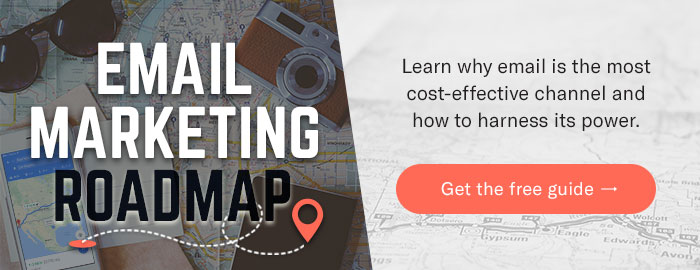No matter what industry you’re in, your business is growing due largely to referral business from your past clients. Consider these two stats:
- 85 percent of small businesses say that word-of-mouth referrals are the number one way that new prospects find out about them.
- eMarketer reported in 2014 that the most successful marketing tool for small businesses (by far) was friend referrals (52.2 percent).
That’s astonishing! Small businesses seem to universally agree that happy customers will tell others and refer their friends. Clearly, word of mouth and referrals are a critical part of any small business, and they just magically happen, right? Not exactly.
Sure, providing excellent service and delivering value to someone counts for something. But what really happens between the time you do business with someone and the time they need to recommend you to a friend on the fly? We’ve all got a lot going on upstairs, and unaided memory recall months (or years) after a client works with you might not be as reliable as you might think.
A while back, we asked 500 real estate agents how many of their past clients were sending them referrals. Surprisingly, they reported that only 20 percent of their past clients sent referrals, despite the majority of their business being referral based.
How then does word of mouth continue to work, and how can you improve its efficiency?
There are two parts to discuss here:
-
- What happens between the time you do business with someone and the moment they refer someone to you?
- How does email marketing work to increase unaided memory recall and referral business?
To better understand the answers to these questions, we’ve got to first look at the standard sales funnel, and more importantly, what happens on the other side of that funnel.
Part 1: The Buyer Journey
AIDA Sales Funnel
AIDA is a marketing acronym that stands for Awareness, Interest, Desire, Action. It’s a somewhat dated representation of the complexities of the marketing and sales process from start to finish but is still a great illustration tool to broadly simplify the process.
Over the years, AIDA has been mapped alongside various funnels to illustrate the marketing and sales process as it relates to the buyer journey from start to finish. All businesses can (and should) map out the journey that their buyers take to get from awareness to closed business.

The funnel of different types of small businesses will take place over varying lengths of time, but will still stick to the core concepts behind AIDA. Here are a few examples featuring two different industries: real estate and HVAC repair.
Awareness: This is the stage when someone finds out about you or your business, either through their own research, your marketing efforts, word of mouth, or by being directly referred to you.
Realtor: Tired of apartment living, John makes the decision to shop for houses and needs to find an agent. His friends all have recommendations for him.
HVAC: Out of the blue, Jane’s AC unit stops working and she needs it repaired. She reaches out to her Facebook friends for advice.
Interest: Think of this as the research phase. Your potential prospect is doing their due diligence to research their options, similar to what you’d do when shopping on Amazon.
Realtor: John has a few names to check out. Half of them don’t have a website and the ones that do, don’t give him enough information.
HVAC: Jane checks out her recommendations on Yelp first, and then Googles them second.
Desire: Nearing the end of their search, the person comes to a conclusion about what it is they want, and that triggers an action.
Realtor: One agent sticks out in particular because of the content on his website. It’s all about the financial benefits of buying a home, and that resonates with John.
HVAC: Jane has two good options. One of the referrals has reviews that talk about the repairman being like a close friend, and she likes that.
Action: This is the point in the funnel that results in a transaction taking place. For a realtor, this process would obviously be longer compared to a repairman. However, both examples end with the acquisition of a new customer.
So now what? Does that person immediately go out and tell their friends? What does the business owner do? Stay in touch and gradually let them slip away? Obviously, you don’t buy a new house every year or need your AC repaired monthly.
The Other Side of the Funnel
Joseph Jaffe wrote a book called Flip the Funnel: How to Use Existing Customers to Gain New Ones. In short, it illustrates how customer retention is the new acquisition and drives home the importance of investing in your customers.
While Flip the Funnel is a good first step, in his presentation on mobile marketing, Jeremiah Owyang presented a Customer Hourglass framework that looks at the buyer journey beyond the sale.

However, while flipping the funnel looks good on paper, it could also imply that you’ll have more advocates for your brand than you will in reality. That’s why I’m a fan of continuing the funnel from the point of sale to keep things more realistic.

Continuing the two examples above, here’s what happens after the business transaction has taken place:
Support: Ever had buyer’s remorse or things not work out as expected? This is the stage where the business owner works to ensure they have a happy client. Things can be frustrating for both parties in this stage, but it’s the first step in creating a long-term relationship.
Realtor: John loves his new home but is lost when it comes to homeownership issues like taxes, furnishing on a budget and insurance. Luckily his agent is there to help.
HVAC: Shortly after the repair, Jane noticed that her AC was running, but not cooling. Her HVAC guy had no problem coming back free of charge to check the refrigerant levels, solving her problem.
Loyalty: This is the stage that happens after all the kinks have been worked out and the customer is content and (somewhat) loyal to you. A lot of companies make the mistake of stopping here (more on that in Part 2 below).
Realtor: John’s been in his house for a few months now and is loving it. His agent made a lasting impression on him, and John is more than willing to send referrals to his friends.
HVAC: Jane made it through the summer without breaking a sweat (pun intended) and couldn’t be happier with her HVAC guy.
Advocacy: Having loyal customers is one thing, but activating them to work on your behalf is how you get referrals. This is the stage where past customers actively refer their friends and indirectly promote your business through word of mouth.
Realtor: John’s friends are now wanting to buy homes, and when asked by his agent if he’s aware of anyone in the market for a home, he’s eager to help.
HVAC: Jane wrote a stellar review for her HVAC guy when he asked her to, and whenever she reads about her friends on Facebook needing HVAC help, she’s quick to point to her Yelp review.
The support stage can happen on its own, but often it needs a conscious effort on the part of the business owner. Loyalty is built up after supporting needs have been met, but over time, while that loyalty might have started strong, it fizzles out by the advocacy stage.
Part 2: Email Marketing Increases Referral Business
The second side of the funnel makes sense. You do good work for your clients, supporting them and creating loyal fans who send you referrals. But there are two things working against you here: time and activation.
Time is not on your side. The further away you get from the transaction date, the less likely that person is to remember you or the excellent work you did, or be able to refer you to new people. Especially for real estate agents, failing to stay in touch with past clients results in a 20 percent loss of their past clients.
Activation is the other issue here. It doesn’t matter if the customer is from a month ago or two years ago; if they’re not actively sending you business (or unable to remember your name when asked), that’s a loss of referral business for you.
This is why only 20 percent of your past clients are sending you referral business. How do you fix this? It’s simple, really: email.
Turning Advocates into Referral Business
The realtor and HVAC examples above are perfect-world scenarios, and in order to make those examples a reality, you’ve got some work to do. This is where email plays a significant role.
How Email Marketing Increases Referral Business
Email is consistently ranked as the single most effective channel for awareness, acquisition, conversion and retention. Long after the sale and support phases of the buyer journey, you’ve got to maintain their loyalty to you, which is tough considering you’re not still doing business with them. A long-term approach to engagement through email marketing will keep you top of mind and help you maintain your credibility.
While past clients might not need your services at the moment, they will still look to you for professional advice on topics you’re familiar with. This is where good email content becomes essential.
Good content is a way to communicate with your audience that offers them information that they want to read. Rather than information specific to your industry or your business, you talk about topics that interest your readers, solve a problem for them or provide useful information.
Email stats don’t lie:
- For every $1 spent on email marketing, the average return on investment is $44.25.
- Email is nearly 40 times better than Facebook and Twitter at acquiring customers.
- 91 percent of consumers check their email at least once per day on their smartphone, making it the most used functionality.
- 70 percent of consumers always open emails from their favorite companies.
Give people multiple opportunities over time to be exposed to your relationship-building content through email. Your name in their inbox increases their ability to easily remember you when the time is right (bonus points if you automate this process).
Email helps you build your long-term relationships, brand yourself professionally, and keeps your past clients engaged and entertained with great content. As a result, you reap the rewards of increased loyalty, advocacy and referral business.
This is how email works to fill the top of your funnel.

Recap
There is a lot more going on after you do business with someone. On the other side of the funnel, the buyer’s journey can lead you to positive word-of-mouth mentions and referral business. However, this journey requires that you support them after the fact to help build loyalty and advocacy.
This can happen on its own but is best accomplished through a long-term approach to email marketing that works to increase loyalty over time.
As I’ve said before, if you’re doing a good job, people will be more than happy to recommend you to their friends. However, we’re all human. We forget details, lose touch and move on with our lives. You have to actively work on building relationships with past clients and staying in touch with them in a proactive way to keep them advocating for your business.



![Better Email Etiquette Equals Better Marketing Results [16 Rules]](https://www.outboundengine.com/wp-content/uploads/shutterstock_411184843-1-400x250.jpg)

